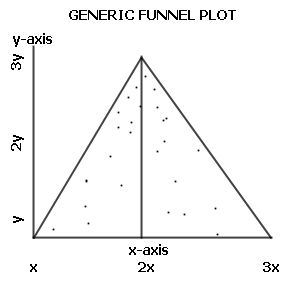Funnel plot
Graphical tool for detecting bias in meta-analyses
A funnel plot is a type of scatter plot used primarily in meta-analysis to check for the presence of publication bias or other types of bias. The plot is a simple graphical representation that helps to visualize the relationship between study size and effect size.
Structure[edit | edit source]
A funnel plot typically plots the effect size from individual studies on the horizontal axis against a measure of study size, such as the standard error or the sample size, on the vertical axis. The name "funnel plot" comes from the shape that is expected when there is no bias: the plot should resemble a symmetrical inverted funnel.
Interpretation[edit | edit source]
In the absence of bias, the plot should be symmetrical because smaller studies will scatter widely at the bottom of the graph, with the spread narrowing among larger studies at the top. If there is publication bias, the plot will often appear asymmetrical because studies with non-significant or unfavorable results are less likely to be published.
Applications[edit | edit source]
Funnel plots are widely used in systematic reviews and meta-analyses to assess the risk of bias. They are particularly useful in the field of medicine, where they help to ensure that the conclusions drawn from a meta-analysis are not unduly influenced by the selective publication of studies.
Limitations[edit | edit source]
While funnel plots are a useful tool, they are not without limitations. Asymmetry in a funnel plot can be caused by factors other than publication bias, such as true heterogeneity between study results, differences in study quality, or chance. Therefore, funnel plots should be interpreted with caution and in conjunction with other methods of bias detection.
See also[edit | edit source]
References[edit | edit source]
External links[edit | edit source]
Transform your life with W8MD's budget GLP1 injections from $125
W8MD offers a medical weight loss program NYC and a clinic to lose weight in Philadelphia. Our W8MD's physician supervised medical weight loss centers in NYC provides expert medical guidance, and offers telemedicine options for convenience.
Why choose W8MD?
- Comprehensive care with FDA-approved weight loss medications including:
- loss injections in NYC both generic and brand names:
- weight loss medications including Phentermine, Qsymia, Diethylpropion etc.
- Accept most insurances for visits or discounted self pay cost.
- Generic weight loss injections starting from just $125.00 for the starting dose
- In person weight loss NYC and telemedicine medical weight loss options in New York city available
- Budget GLP1 weight loss injections in NYC starting from $125.00 biweekly with insurance!
Book Your Appointment
Start your NYC weight loss journey today at our NYC medical weight loss, and Philadelphia medical weight loss Call (718)946-5500 for NY and 215 676 2334 for PA
Search WikiMD
Ad.Tired of being Overweight? Try W8MD's NYC physician weight loss.
Semaglutide (Ozempic / Wegovy and Tirzepatide (Mounjaro / Zepbound) available. Call 718 946 5500.
Advertise on WikiMD
|
WikiMD's Wellness Encyclopedia |
| Let Food Be Thy Medicine Medicine Thy Food - Hippocrates |
Translate this page: - East Asian
中文,
日本,
한국어,
South Asian
हिन्दी,
தமிழ்,
తెలుగు,
Urdu,
ಕನ್ನಡ,
Southeast Asian
Indonesian,
Vietnamese,
Thai,
မြန်မာဘာသာ,
বাংলা
European
español,
Deutsch,
français,
Greek,
português do Brasil,
polski,
română,
русский,
Nederlands,
norsk,
svenska,
suomi,
Italian
Middle Eastern & African
عربى,
Turkish,
Persian,
Hebrew,
Afrikaans,
isiZulu,
Kiswahili,
Other
Bulgarian,
Hungarian,
Czech,
Swedish,
മലയാളം,
मराठी,
ਪੰਜਾਬੀ,
ગુજરાતી,
Portuguese,
Ukrainian
Medical Disclaimer: WikiMD is not a substitute for professional medical advice. The information on WikiMD is provided as an information resource only, may be incorrect, outdated or misleading, and is not to be used or relied on for any diagnostic or treatment purposes. Please consult your health care provider before making any healthcare decisions or for guidance about a specific medical condition. WikiMD expressly disclaims responsibility, and shall have no liability, for any damages, loss, injury, or liability whatsoever suffered as a result of your reliance on the information contained in this site. By visiting this site you agree to the foregoing terms and conditions, which may from time to time be changed or supplemented by WikiMD. If you do not agree to the foregoing terms and conditions, you should not enter or use this site. See full disclaimer.
Credits:Most images are courtesy of Wikimedia commons, and templates, categories Wikipedia, licensed under CC BY SA or similar.
Contributors: Prab R. Tumpati, MD



